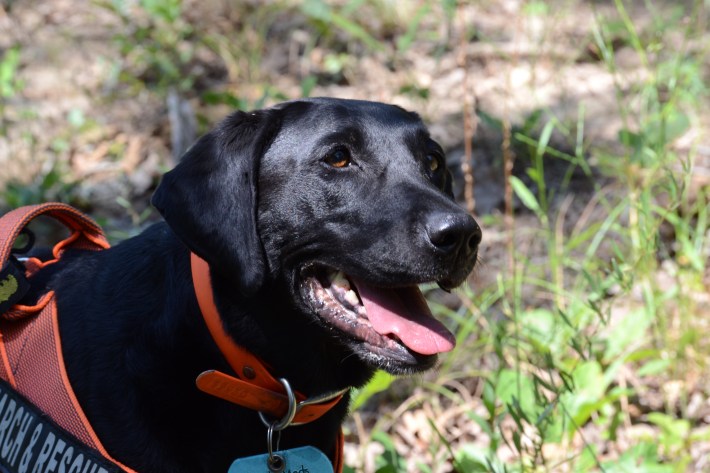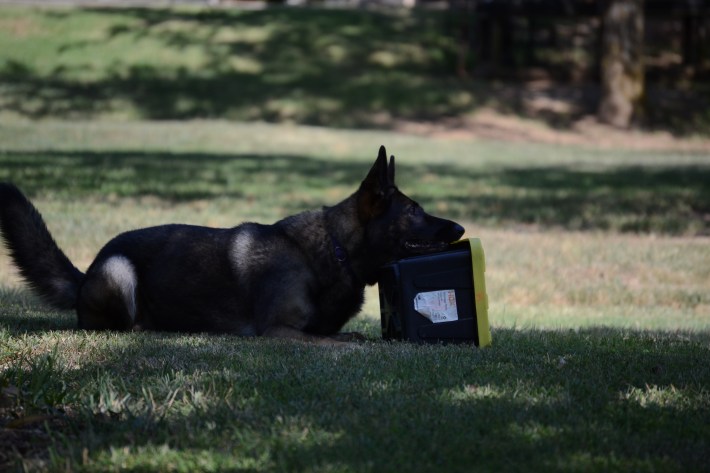It was a blistering Saturday in July, and we were lost in the woods on purpose.
Three of us sat in a reinforced golf cart, parked under a young tree whose shade didn’t quite keep the heat off. Ahead of us was a clearing roughly 20 feet across, covered with tall grass that blazed green in the midday sun. Quicker than we expected, a shape appeared in the clearing.
A black lab trotted methodically through the tall grass, nose to the ground, accompanied by two people. Soon they were out of sight again, before briefly reappearing on our 3 o’clock, and then, directly behind us. This time, the dog found us. She wiggled up to us some distance ahead of her handler, and together we lavished praise upon our little savior.
In the office, at home, in the car, you can kid yourself into thinking that modernity has somehow tamed and hemmed in the elemental world. But the woods are still there to get lost in. Industrial society is a mushroom growing on a tree older than reckoning. You can drown in an inch of water, you can get struck by lightning inside, and you can still get lost in a world with GPS navigation and modern telecommunications.
Without that black lab, in a more dire situation, we’d be dead.
Dogs have been trained to find missing people for centuries. Some of the earliest examples are the famous St. Bernards used by monks in the Swiss Alps to rescue lost travelers. More sophisticated training methods were developed in the early 20th century, for locating missing soldiers during the World Wars. Later, in the 1970s, police developed training for “cadaver dogs,” specifically trained to locate dead tissue.
Nowadays search and rescue dogs are used by all kinds of organizations to locate missing people under lots of different circumstances. Common situations include very young children wandering off, or elders becoming confused and disappearing. Certain diagnoses, such as autism or Alzheimer’s, can increase a person’s risk.

Clara the black lab and her trainer Dan are a search-and-rescue team with Red Dirt Oklahoma Search and Recovery (OSAR), a volunteer-run organization specializing in canine search and rescue. Founded in 2021, OSAR helps locate missing people across the state. Even though law enforcement and other first responders have resources to look for missing people, training and handling SAR canines is a skill unto itself, to which municipalities may not have the resources to commit training.
OSAR fills this gap with volunteer labor, functioning as a “force multiplier” for rescuers without the associated costs. Sometimes they go for months at a time without being called out; other times they’re out three times in two weeks. The details of field operations are confidential.
Common Scents
Earlier that morning, my fellow volunteers and I were greeted by Heather, one of the original members of Red Dirt OSAR. Her passion for the world of canine search-and-rescue started with a talented chocolate lab named Rumble. After getting, as Heather told me, “bored with life as a therapy dog,” he and Heather started getting certified as rescue workers. Heather is now Red Dirt OSAR’s senior member.
This was a training session, as much for the handlers as it was for the dogs. A handler has to consider terrain, weather, wind direction, animal psychology and even human behavior when deploying their canine. Each volunteer is licensed with the FCC as a radio operator. The group also studies lost person behavior, a field that uses collected data to predict how a lost person is likely to behave under specific circumstances. They teach classes, too, like their “Hug a Tree” course aimed at kids. (If you’re lost, you can do yourself a big favor by “hugging a tree”—in other words, staying put and letting them find you.)
Once we signed our releases, Heather gave us some basic information about their craft. "Working the dog,” she explained, “is very strategic." Red Dirt OSAR trains what are known as area dogs. Within this group are several different subtypes, the first of which are Area Live-Find dogs. These dogs use the wind to detect the scent of live humans and track them down. Our bodies are constantly shedding cells; simply by occupying a space, we generate a "scent pool" that dogs can recognize and track.
"Everybody's odor is unique," Heather said. "Even identical twins can be differentiated by a dog because their body chemistry is going to be different." Area Live-Find dogs work "nose up," catching scents on the wind over long distances. (There are two subtypes of Area Live-Find dogs: Scent-Specific and Scent-Nonspecific. Nonspecific dogs will find any human scent in the woods. A Scent-Specific dog, however, can learn to identify individuals and locate them in the wild.) When using this type of dog, the handler must weave back and forth perpendicular to the direction of the wind. This helps the dog pinpoint the exact location a scent may be coming from.
There are also Trailing Dogs, which can be trained to detect living or deceased subjects. While an area dog will search a wide zone for a scent and find the origin, a trailing dog can follow a specific scent path laid down by a missing person. Given a scent article to train them on the scent they are meant to follow, these dogs then work "nose down," finding and following the scent on the ground.
"Every step that you take," Heather told us, "whether it be walking, or on a horse, or on a bicycle, or a scooter, or in a car: if the dog is trained, they can trail that."
No Bones About It
Then there are Human Remains Detection (HRD) dogs, which are exactly what they sound like. Training these dogs is tricky; they need to be taught on real samples of dead human tissue. Every part of the human body has a different scent to the canine nose, meaning that an HRD dog must be trained with a variety of samples.
Sourcing can be a challenge, although Red Dirt OSAR has found some workarounds. Some hospitals allow surgical patients to donate excised flesh and bone; replaced knees and hips can enjoy a brief afterlife as a crucial tool for search and rescue training. The same goes for lengths of intestine, placentas, teeth, and anything else that happens to drop off the human body. Some trainers use blood, although HRD dogs that specialize in cold cases may not do this, since there may not be any blood if the body is thoroughly decomposed.
"You can actually buy bones online, believe it or not," said Caitlin, another dog trainer. Still, it's hard to train under the exact same conditions one finds in the field.
As a German Shepherd HRD dog, Gabi's playful demeanor somehow complemented her grim occupation. Today’s training was a simple signaling drill: Gabi was placed in a circle of identical plastic boxes, each with a circular hole drilled in the side. One of these boxes contained human remains, which she was to locate and signal to her trainer. She sampled some of the boxes for familiar scents. Then, the wind changed, and the smell of human remains drifted over to her from a box to her right.

She quickly trotted over to that box and stuck her nose in the hole. She had found the right box, but hadn’t signaled yet. She tried another box, maybe to be sure, or maybe just to keep the game going. Finally, she lay down and put her nose right next to the hole in the box: the signal she had been trained to give. Gabi received praise and treats, dispensed right next to the target to reinforce her training. Satisfied, she rested her head on the target box and wagged her tail, a big grin on her face.
Training these dogs is partially a matter of expanding their scent library. "Once you have that scent in their brain, it's there forever," said Heather.
"Homicides smell different than suicides," she explained. "Everything that you do affects your body chemistry, which affects your odor." The anxiety of self-termination, or the fear and adrenaline of murder, alter the body physically. Dogs, so attuned to humanity after millennia at our side, can almost read our thoughts as they take chemical shape in our bloodstream. They can hear the echoes of our last thoughts, even after we have ceased to be. Dogs can tell what disease you had when you died, and detect the medication settling in your bloodstream. About 30 minutes after death, a body's smell begins to change to the dog's nose.
"When a dog finds a body, they've been hit with the whole wall of odor," Heather said.
"Also, the scent pool can be so much bigger with a full body versus what we get to train on," added Liz, another trainer. Liz worked a stable desk job for “corporate America,” as she put it, and became a rescue dog trainer to do something helpful for others. Heather and Liz are going to visit a body farm in Texas soon as an educational field trip. Currently the group only uses small samples of dead tissue for training, nothing over six grams.
When cadaver dogs are trained they're gradually introduced to the smell of a body, beginning with the feet and ending with the face. "They don't see faces out here. They see jars and metal containers. So the first time they see a [dead person’s] face, they're going 'Oh, this is what I'm finding,'" said Liz. Dogs’ reactions to this can vary. Dogs look to our faces for direction and connection, so seeing a dead person’s face can be very upsetting to them. Some go into shock. Some dogs don't like working these kinds of cases at all.
Ruffing It
After Clara the black lab found us and her training was finished for the day, I waited behind for the next trainee to locate us. After a short time, a streak of golden brown shot across our line of sight before darting back in the direction it came from.
This streak was Nova, an exuberant young German Shepherd, followed by her trainer Caitlin, and Geraldine, a volunteer observing the training. By the time Nova found us, Geraldine and Caitlin knew something was up: Nova had taken the exact same route as Clara. That meant she was tailing the other dog, rather than scanning the wind with her nose for us.

Adjusting for this kind of behavior requires an experienced and knowledgeable handler. Dogs are smarter than we tend to think, and they have all kinds of ways to cheat. Some dogs are specifically trained for trailing, and this can make it difficult to hide targets from them. They can cheat by following the scent of the living trainer, or another dog.
Sometimes you can have the opposite problem: a dog may lollygag or ignore the target. You have to forgive them; to the dogs, it’s all a big game with a treat at the end. Why not keep the game going a little longer?
After a short wait, Dan set out with a spry tan hound named Shelby while I followed. Our route took us past our old hiding place, invisible from the main track. We crossed a ridge and made our way down to a meadow bounded by trees on our left-hand side, Gabby weaving back and forth across the trail. At the bottom of the ridge the trail divided in two, one track leading into the woods to our left, the other wading into the meadow to our right. After some deliberation, Shelby steered us to the right.

Shelby’s excitement was palpable. A working dog through-and-through, her preferred method of searching was to sprint in every direction imaginable until she caught a whiff of the target. Working with this type of dog presents its own challenges for the trainers, who must keep the dogs on task without giving the game away.
Training a dog correctly is an art unto itself. As tempting as it may be, trainers are forbidden to give the canine any hints. I kept this in mind as the golf cart came into view on the other side of the meadow, hiding in the shade of the treeline. Shelby couldn’t see them from her point of view. Even if she could, the point of the exercise was to detect their scent. The “rescue” party and the “lost persons” scrupulously ignored one another until the dog solved the riddle for herself. It didn’t take long for Shelby to catch the scent and bound off to the lost persons, who greeted her as befitting her heroism.
Out Of The Woods
What makes Red Dirt OSAR special is their seriousness and commitment to understanding this often-misunderstood side of the world. They are all volunteers, giving up their time and personal resources in furtherance of their training. They train multiple times every week, often traveling to train in different areas or with different people, constantly learning new things. They also teach classes on lost person behavior and how to protect yourself if you or a loved one goes missing.
It’s not easy, of course. They’re always in need of outdoors equipment, cash, places to train, or simply time and energy. If you’re looking for a meaningful way to spend your weekends and you don’t mind getting slightly, manageably lost in the wilderness, you can contact them through Facebook or through their website. And if you get lost out there, remember to hug a tree, and don’t stop until a dog finds you!







